Ulysse Nardin Freak X: The ‘Affordable’ Freak
Did you know that the first ballpoint pen was invented in 1888 but failed because it didn’t write well on paper? It was designed to write on rough materials like wood and leather (which it did successfully), and due to manufacturing limitations the quality of the writing was rough. The pen was not a commercial success.
The original patent lapsed, and it wasn’t until 1938 that the first commercially viable ballpoint pen was patented. It was technically advanced, a feat of engineering.
As such, due to manufacturing requirements that saw tolerances of around .01 mm for proper function, the first pens were notably expensive. When I say expensive, I mean $12.50 for a single ballpoint pen in 1945 (or $178 adjusted for inflation).
But people in that time thought it was a bargain, and they sold out by the thousands across the industrialized world as they revolutionized writing with capabilities beyond any normal fountain pen.
For a while the prices reflected the advanced technology of the pens, but, alas, the marvel that was the ballpoint pen fell victim to the march of progress. By the time Marcel Bich (who shortened his name to Bic for ease of pronunciation internationally) introduced his Bic Cristal to the American market in 1959, the price had dropped to just 29 cents (around $2.50 in today’s money).
The marvel of engineering that had completely changed how people wrote forever was now a common, inexpensive, run-of-the-mill product sold for a fraction of the original.
Now you may be shaking your head because as I am lamenting the reduction in cost of the ballpoint pen, a true feat of mechanical engineering and manufacturing. And you might be thinking about how popular it is and how cheap they are now so that everyone, everywhere, can own one.
The ballpoint pen made permanent writing devices a democratized product for the masses. To which I say boo: it has sullied the good name and prestige of the ballpoint pen and cheapened the engineering that went into the earlier groundbreaking pens.
Gotcha!
No, I don’t think that, nor do I think anyone would legitimately think that the ballpoint pen deserved to stay an expensive tool for writing and affordable only by the wealthy.
You might also ask if that isn’t the point of research and development and advancements in manufacturing techniques: the ability to produce awesome (and often better) products at lower prices. The most common answer will probably be yes.
If I were to replace the words “ballpoint pen” with, say, “perpetual calendar,” “60-second tourbillon,” or “minute repeater” (gasp!) I imagine that people’s reactions to the idea of an affordable version for everyone might be significantly different.
Why is that? Well for one we value these differently, but also we have been conditioned to think that everyday consumer products are supposed to get cheaper over time (think HD TVs and microwaves), but not high-end watches.
No, no: those are supposed to stay exclusive and very high priced, otherwise it cheapens what came before and makes the collectors that paid tens of thousands to buy them look like fools. But that isn’t how it works, or at least it shouldn’t be.
So why do I bring this up? Ulysse Nardin, that’s why.
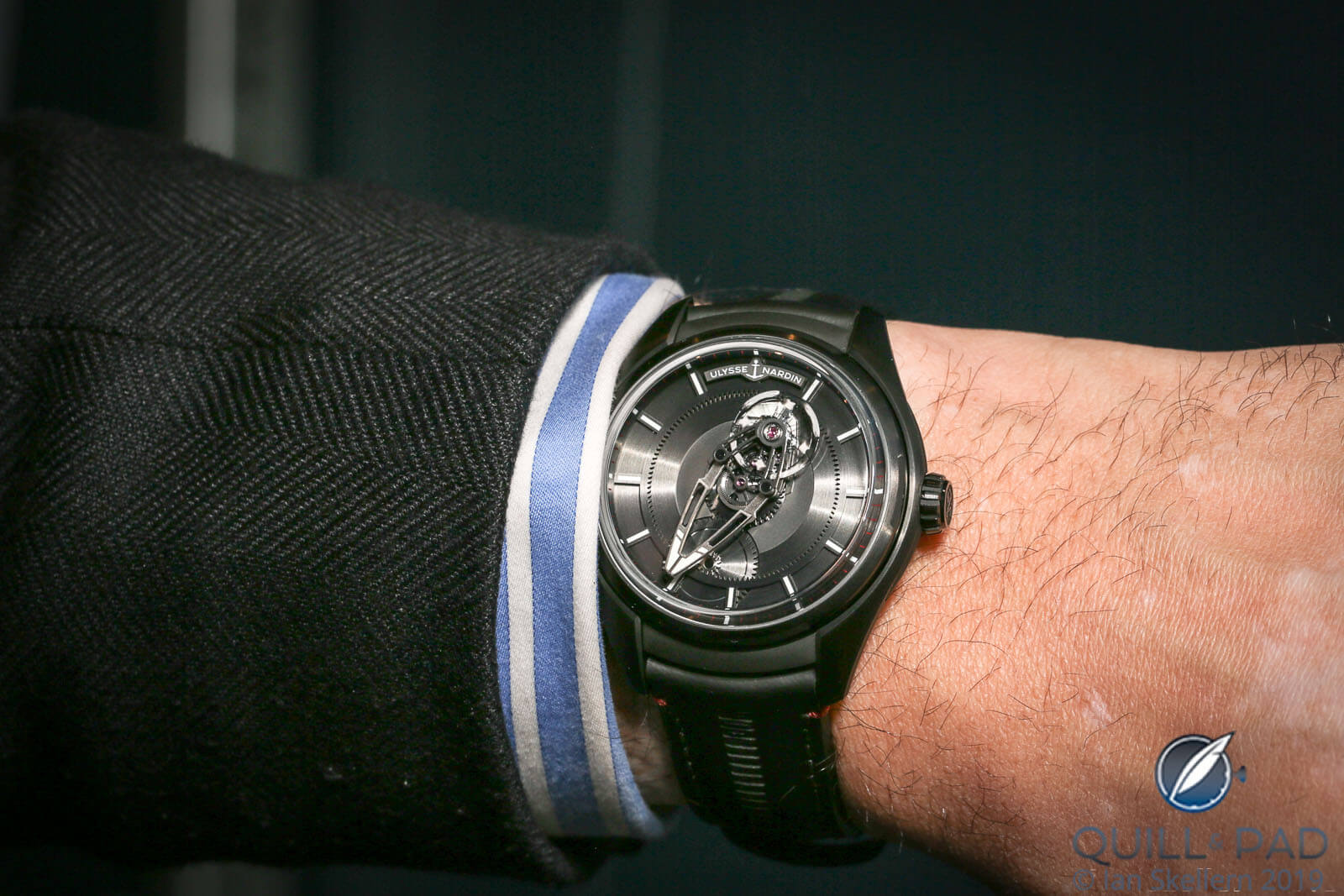
Ulysse Nardin Freak X on the wrist
Ulysse Nardin rocked the proverbial high-end watchmaking boat in a big way at SIHH 2019 with the release of the Freak X, an entry-level variation on the epic and iconic Freak. The Freak X that single-handedly created modern avant-garde watchmaking when it made its debut in 2001.
The new Freak X takes a bunch of what Ulysse Nardin has developed over the past two decades and cleverly combines it into a simplified (in a sense) timepiece that is one-fifth the price of the regular Freak.
This sent a sizable shock wave through the industry that was palpable during the fair, and the reactions were definitely a mixed bag.
The Ulysse Nardin Freak X: a new direction
The Freak X is, quite simply, an awesome watch at a fantastic price.
Starting at just $21,000, the Freak X is not a full Freak (to be expected) but instead a pared-back version that keeps the essence of the idea while ditching some complication in search of efficiency.
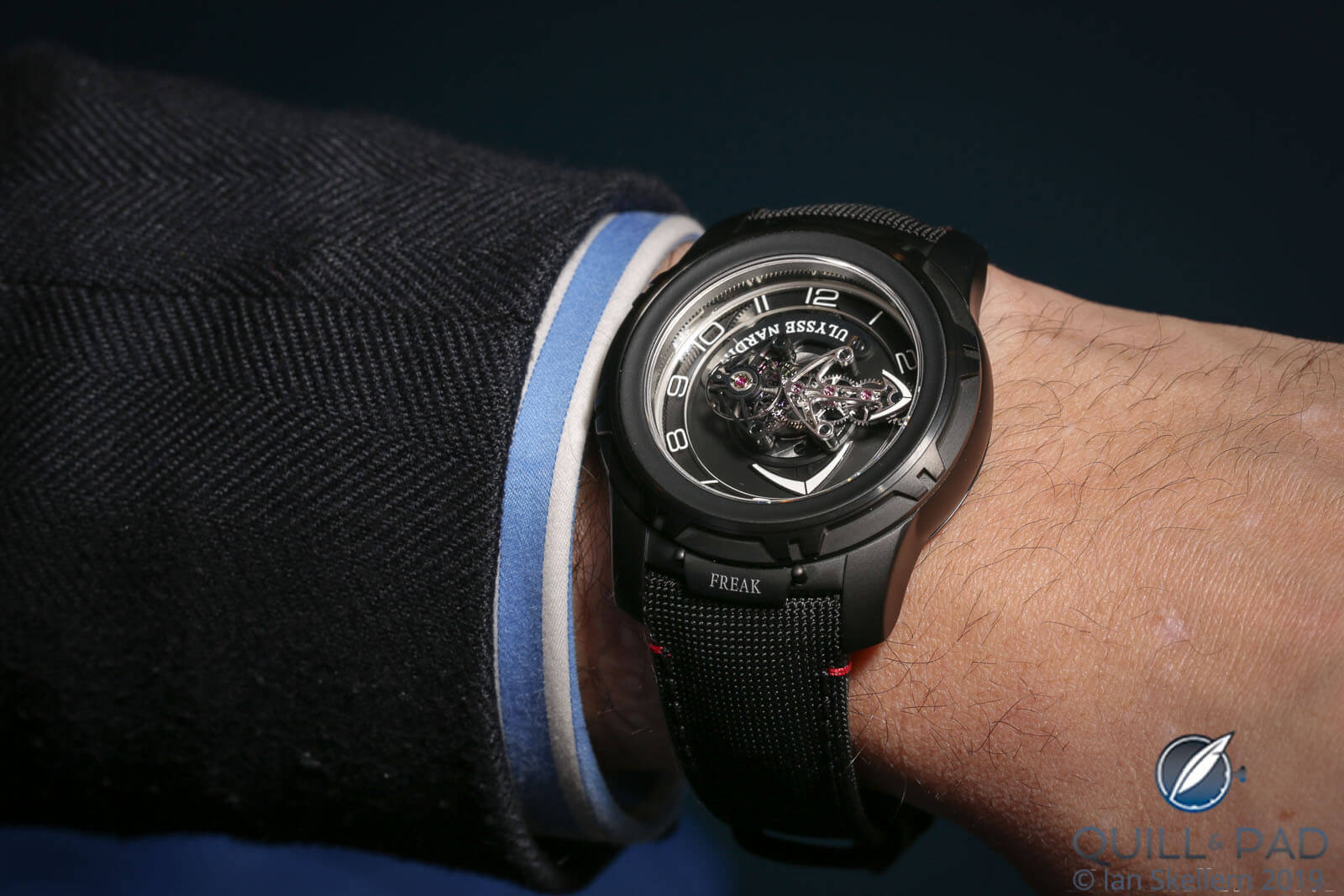
Ulysse Nardin Freak Out on the wrist
The core idea behind the Freak was always the balance and escapement assembly mounted upon a rotating frame that doubled as the minute hand. To me, this is what defines the Freak. Of course, it isn’t that simple. But it is the aesthetic and mechanical core of what the Freak is.
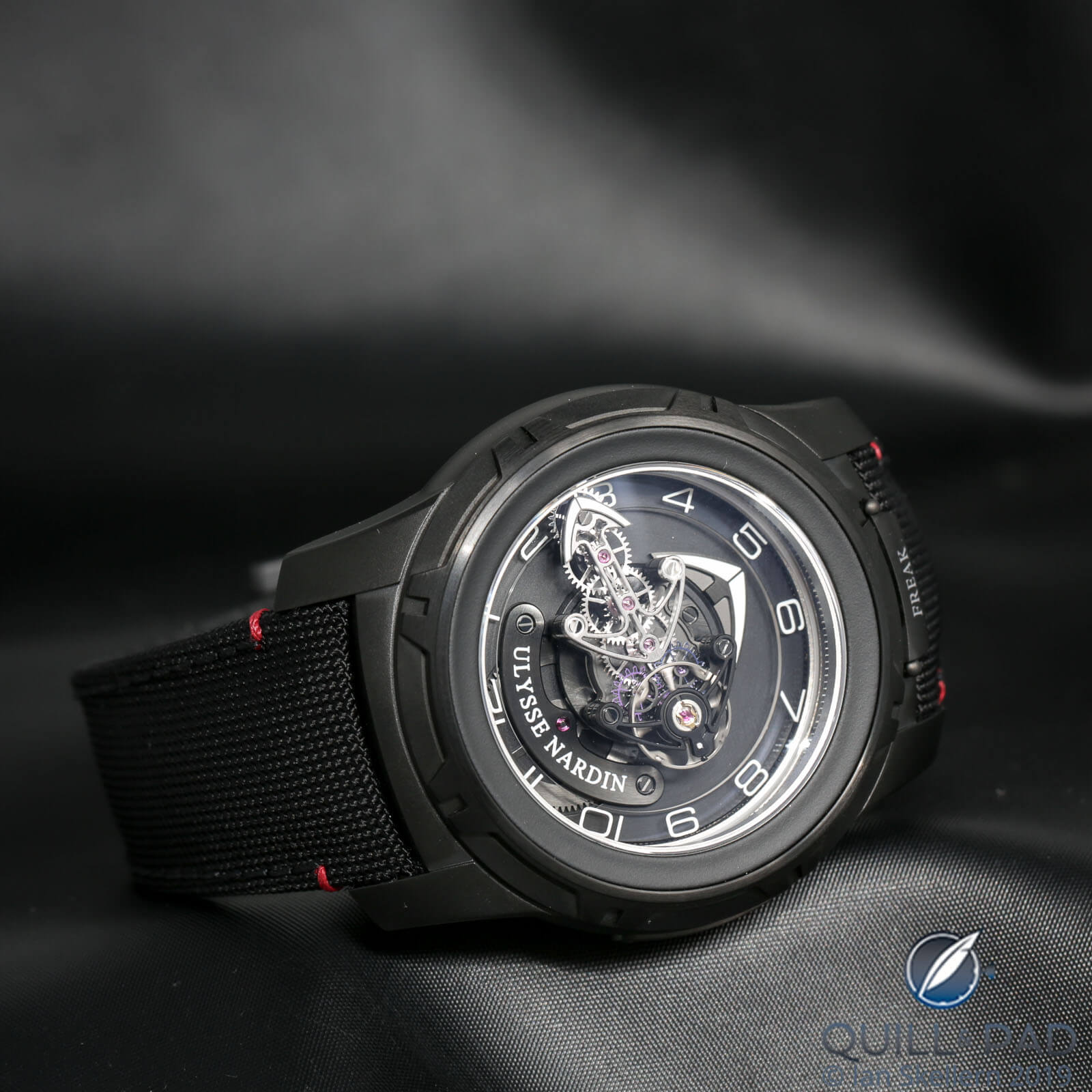
Ulysse Nardin Freak Out: the latest version of the ‘classic’ Freak
The new Freak X has this as well as the hour hand attached to a large geared disk rotating underneath.
But another big feature of the original Freak is missing: the bezel that replaces the crown for winding and setting. Instead, in search of simplicity and cost reduction, a traditional crown supplants the original winding system, taking the Freak X one step closer to a “normal” timepiece.
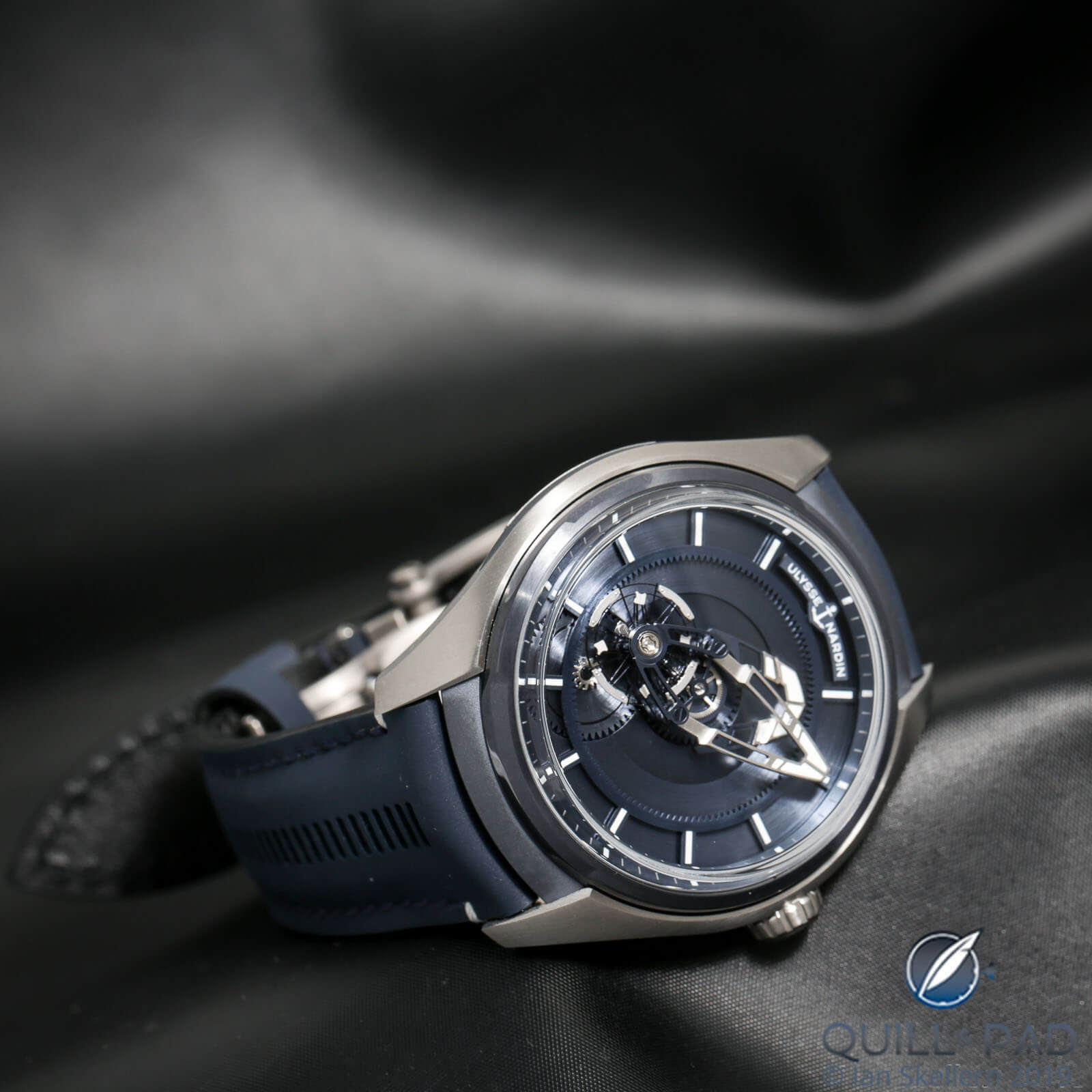
Ulysse Nardin Freak X with blue dial in titanium
The case is smaller and thinner as a result of this simplification, a definite plus for many collectors regarding wearability. But that isn’t the only easy-to-spot change.
On all previous Freak models, part of the going train has been mounted on the minute hand caroussel frame, turning the entire length of the frame into a bridge holding the wheels in the proper orientation. At the end of the minute hand, a wheel meshed with an internal ring gear encircles the edge of the dial.
This meant most of the movement gearing was visible at all times, however this is no longer the case. The minute hand frame only carries the balance and escapement, with the rest of the gearing appearing below in a planetary gear system or hidden beneath the hour disk.
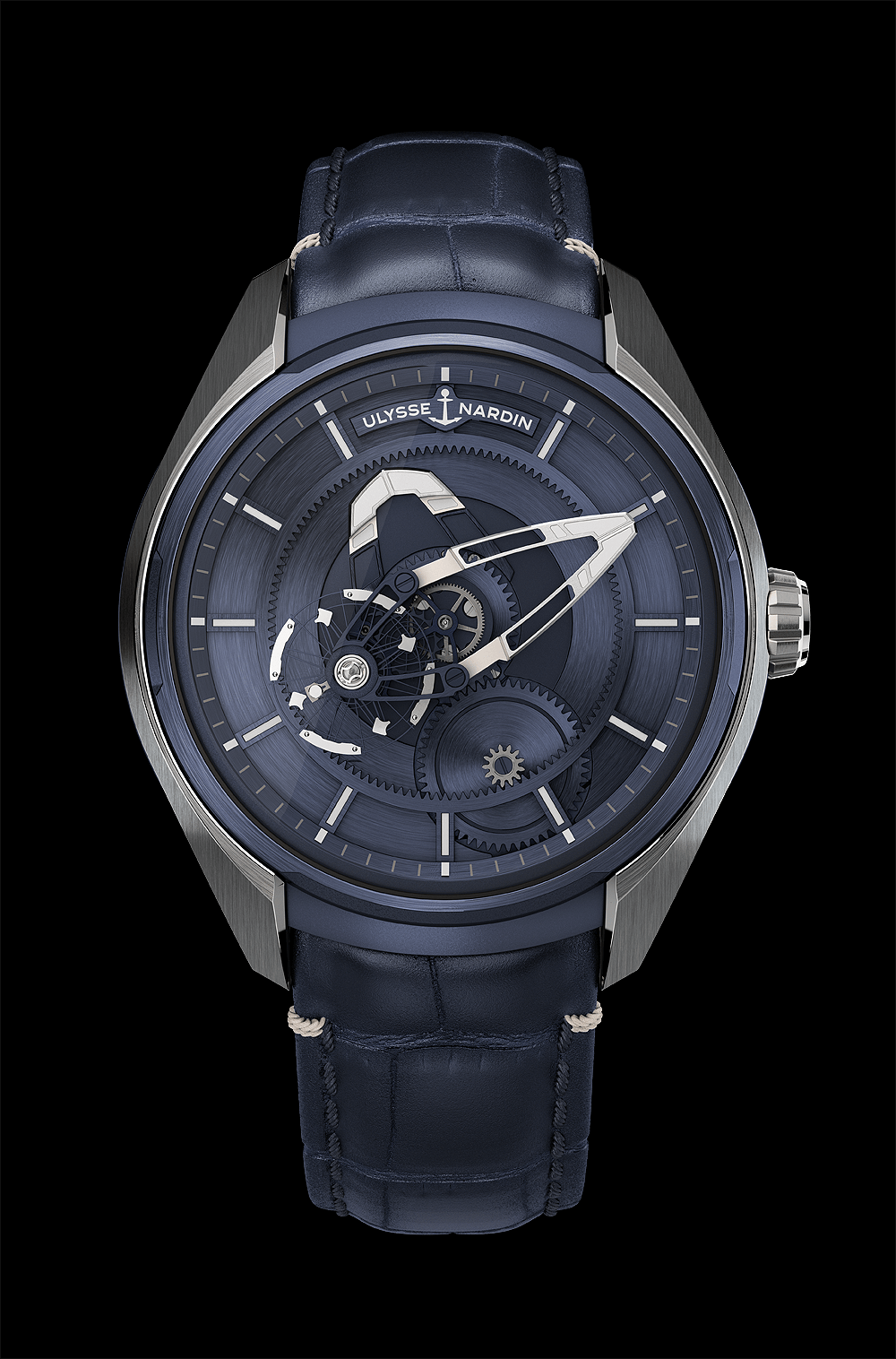
Ulysse Nardin Freak X with blue dial in titanium
This greatly simplifies the visual aesthetic of the dial as the frame is now mostly empty and acts chiefly as the minute pointer. The simple aesthetic continues through the case, which is a somewhat traditional shape with sloping lugs that feel separate from the case middle, and hug the inset shape. The lugs act kind of like bookends for the case band, allowing a bit of the middle to poke through around the crown on the opposite side.
The bezel, which used to be a functional component, is now reduced, though still given some detail with sections of chamfered corners on an otherwise clean edge.
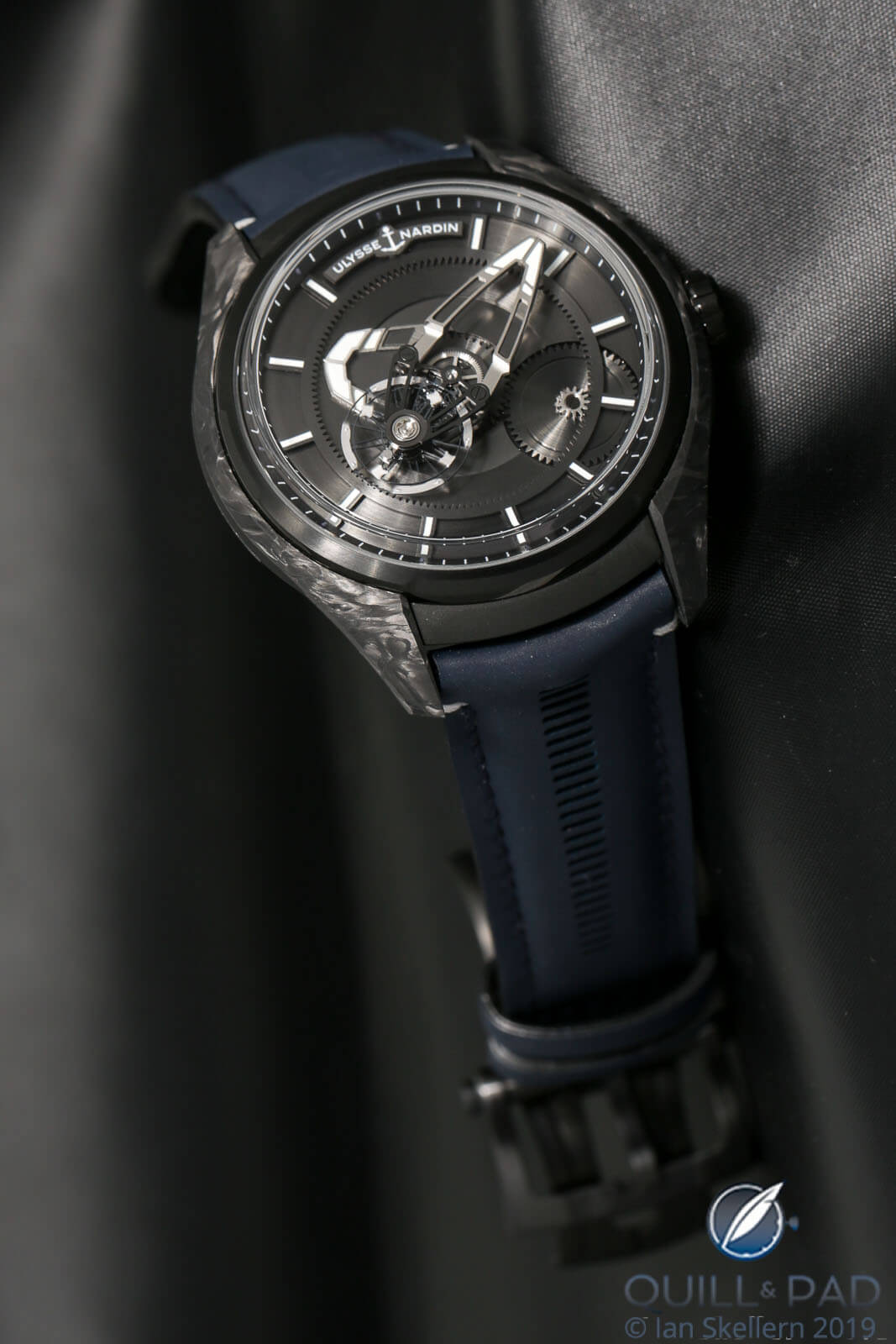
Ulysse Nardin Freak X in forged Carbonium and titanium
On the rear of the case is another big change: there is no longer a giant mainspring taking up the entire window topped by the new Grinder automatic winding mechanism. Instead we see a fairly “standard” movement with a rotor and the patented “Magic Lever” bi-directional automatic winding system.
While some would say this is the final proof that this isn’t really a true Freak, I would argue otherwise.
Ulysse Nardin Freak X: innovation in action
The Freak X is the inevitable result of nearly two decades’ worth of research and material development. When we look back at the original Freak from 2001, as earth shattering as it was, it almost looks like a poor man’s rendition of the Freak when we compare it with the last few examples (see one in Ulysse Nardin Freak Vision: Promises Realized).
The technology has come so far that the simple Freak X looks more cutting edge than the first couple of Freak models. This has to do largely with the clean simplicity and delicate structure of the caroussel and balance assembly.
The balance wheel, hairspring, escape wheel, and escape lever are all made of silicon, a level of silicon fabrication that wasn’t seen on the Freak until the InnoVision in 2007 and later models.
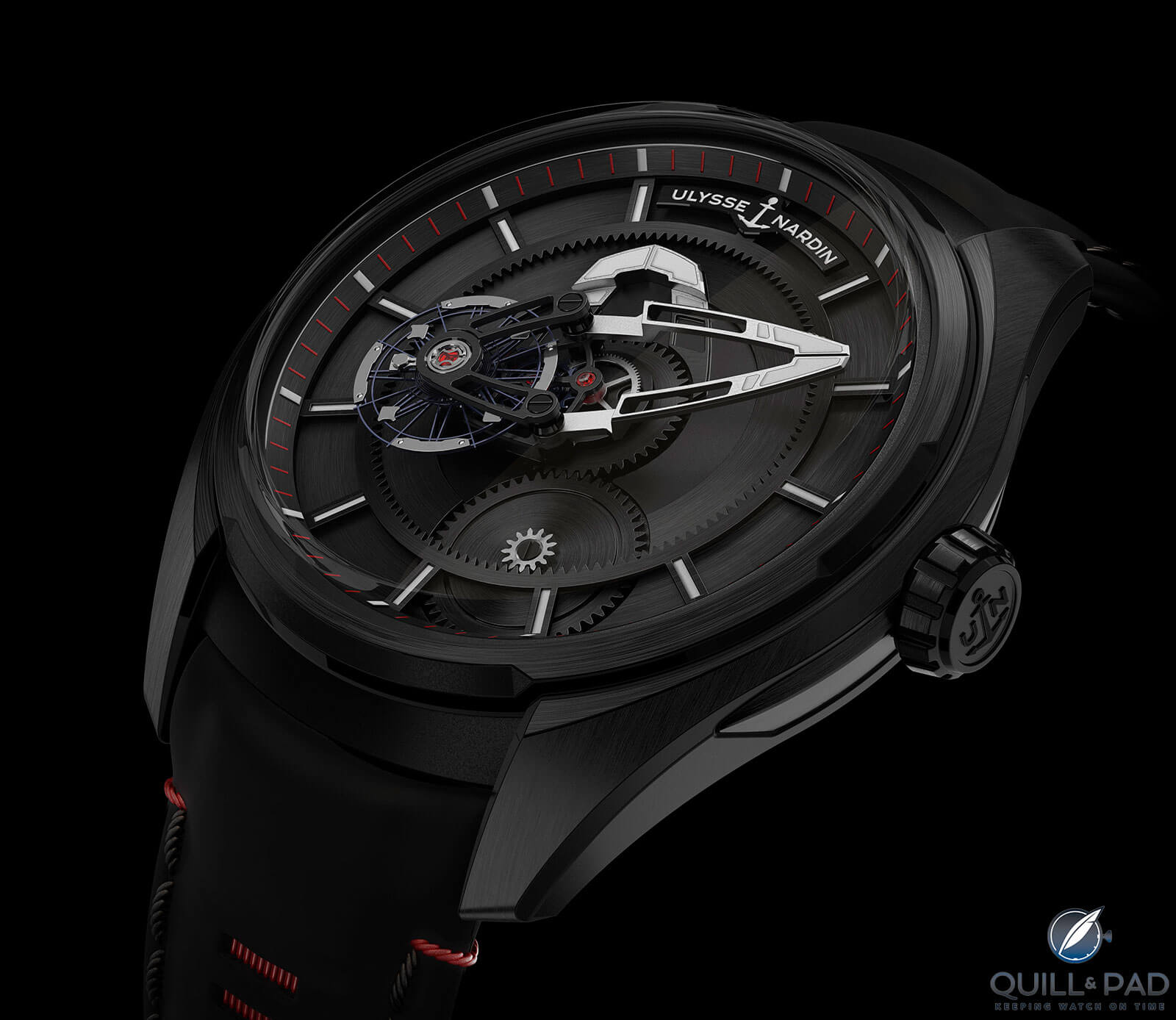
Ulysse Nardin Freak X in black DLC-coated titanium
The balance is very complex and features poised and fixed nickel flyweights as well as integrated stabilizing micro blades between the spokes of the wheel. The entire mechanism is non-magnetic, temperature resistant, dimensionally stable, and lubrication free, something that was still yet to come for the early Freak models.
The refinement seen in the caroussel is a combination of a variety of innovations from Ulysse Nardin over the years simplified into a cohesive yet technically advanced design. It may not reach the level of the InnoVision 2 or the most recent Freak NeXt, but it definitely is beyond the origins of the Freak and fits nicely within the ranks.
The movement, Caliber UN-230, is a blend of both Caliber UN-118 and the Freak Vision’s UN-250, with the “party” up front and all the business in the back.
And don’t think for a moment that this watch is old tricks in new clothes: one of the Freak X versions also features a new case material that proves the Freak models will remain part of the brand’s technical push forward. The new material called Carbonium is a type of forged carbon composite that utilizes recycled offcuts of carbon fiber material salvaged from aerospace manufacturing processes.
The brand claims the process reduces the carbon footprint by 40 percent over other carbon products because it uses already-produced material, thus cutting out the production effort for virgin material. Utilizing salvaged offcuts makes perfect sense here since forged carbon doesn’t require pristine woven sheets, but rather loose chopped fibers, allowing increased efficiency while creating a robust material. Definitely an indication that research and development isn’t reserved for the top-of-the-line products.
Why Ulysse Nardin’s Freak X makes perfect sense
The Freak collection has been the leading R&D outlet for Ulysse Nardin for 20 years, and the results in Caliber UN-230 are pretty clear: you can get some rather amazing mechanics in a more consumer-friendly package than many would have thought possible. And that is the point of doing research and development.
By my last count, at least seven out of ten innovations in the first InnoVision watch are now found in production pieces. That means that the research lab isn’t just doing research for the fun of it, but to actively improve the entire brand. So it should come as no surprise that eventually we would see a Freak taking the concepts sprinkled throughout the Freak’s greatest hits and, using the brand’s expertise, combine them into a new offering pushing new boundaries, namely affordability.
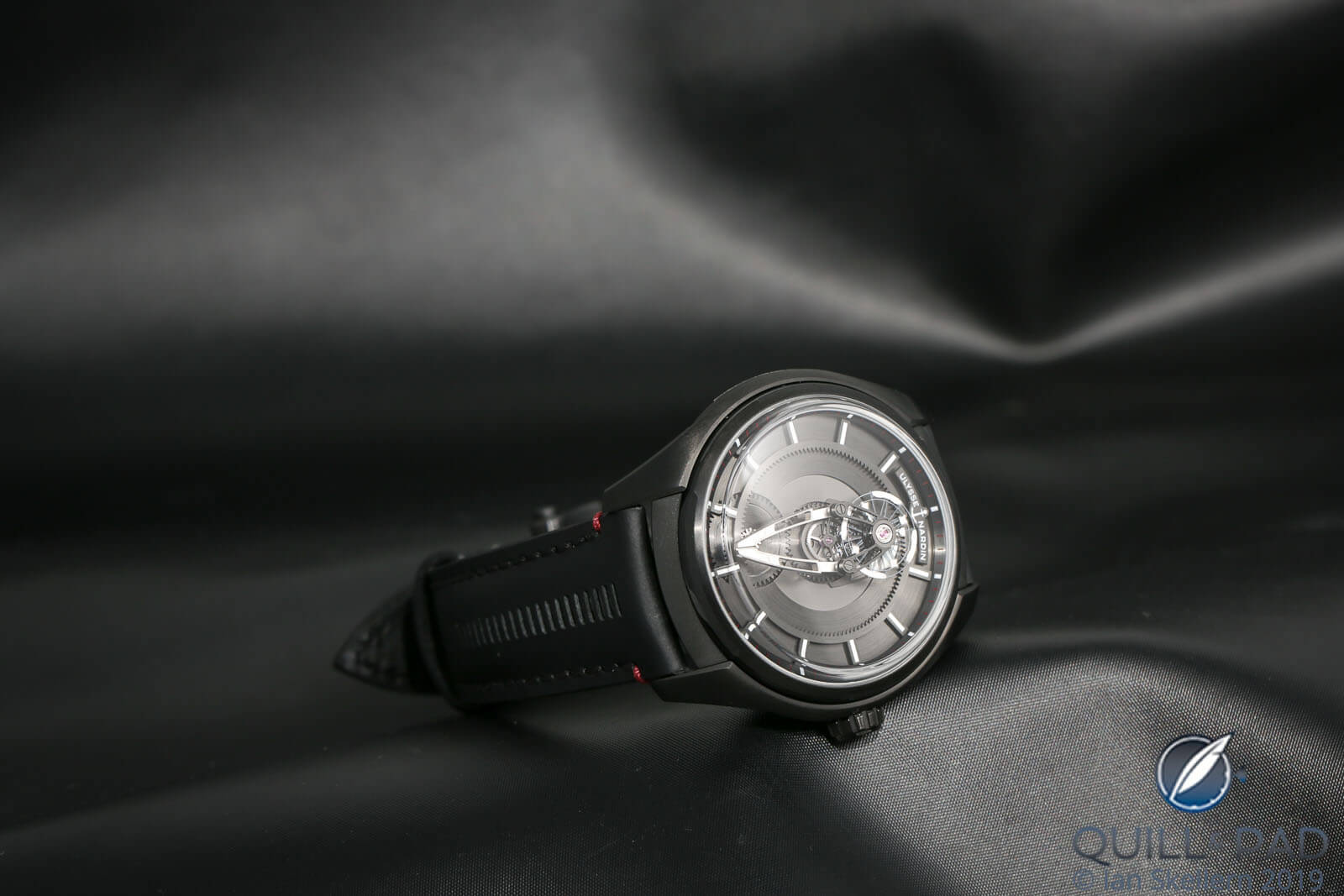
Ulysse Nardin Freak X in titanium
If anything, the reality of the Freak X is that compared to its contemporary brethren it is mild and nearly acceptable as an avant-garde timepiece. In this day and age, its design is relatively middle of the road when it comes to extreme mechanics and design – and we have the last two decades of development to thank for that.
The Freak X is the acceptable Freak, the Freak that shines up nicely and makes it through the whole wedding ceremony without making a scene. Sure, it’ll cut it up on the dance floor because it’s still wild at heart, but the Freak X won’t leave people shocked and slack-jawed.
And I think that is precisely why people have had mixed feelings about a true entry-level Freak, feeling it was lacking some iconic Freak features.
The last two decades have seen the Freak collection pushing boundaries and making scenes. Every new Freak did something unexpected or challenging, and so to tame that down feels sacrilegious. But if a brand is going to invest that much money and effort to create such amazing things, then (when they perfect them) it only makes sense to make it available for a wider audience.
The same type of handwringing over the Freak X happened when Frédérique Constant made a sub-$9,000 perpetual calendar and when TAG Heuer released a $16,000 tourbillon chronograph: industry insiders and collectors alike worried it would sully the prestige of the mechanisms and cause interest to wane.
But true passion isn’t dissuaded by affordability or accessibility; people are just excited that they get a chance to be part of the club.
I am not under the illusion that a price beginning at $21,000 makes this watch truly “affordable,” but it does make it a possibility to obtain should things go well. A determined average collector could definitely seek to acquire a Freak X one day, and he or she would probably cherish the chance to own the Freak’s little brother.
That opportunity does nothing to diminish the extreme nature of the top-of-the-line Freak models, nor would it make those who purchased the originals feel like it was a waste. At least it shouldn’t.
The Freak X is fairly different and definitely missing some of what makes the Freak truly stand out. But thanks to investments in manufacturing and the development of technologies, the Freak X can do what most brands can’t: offer a good facsimile of the top-of-the-line models at a reasonable price that can stand on its own as a top-notch watch.
In my mind, the Freak X is not only long overdue but also extremely disruptive. Ulysse Nardin has shown that hoarding the coolest stuff for the uber wealthy doesn’t have to be the modus operandi; it should be the purpose of all research and development to lead toward implementing advancements in all levels of the products you sell.
A lot of the tech from the Freak line, especially with silicon hairsprings and escape wheels, has found its way into normal, everyday watches, and it’s made the entire brand that much better.
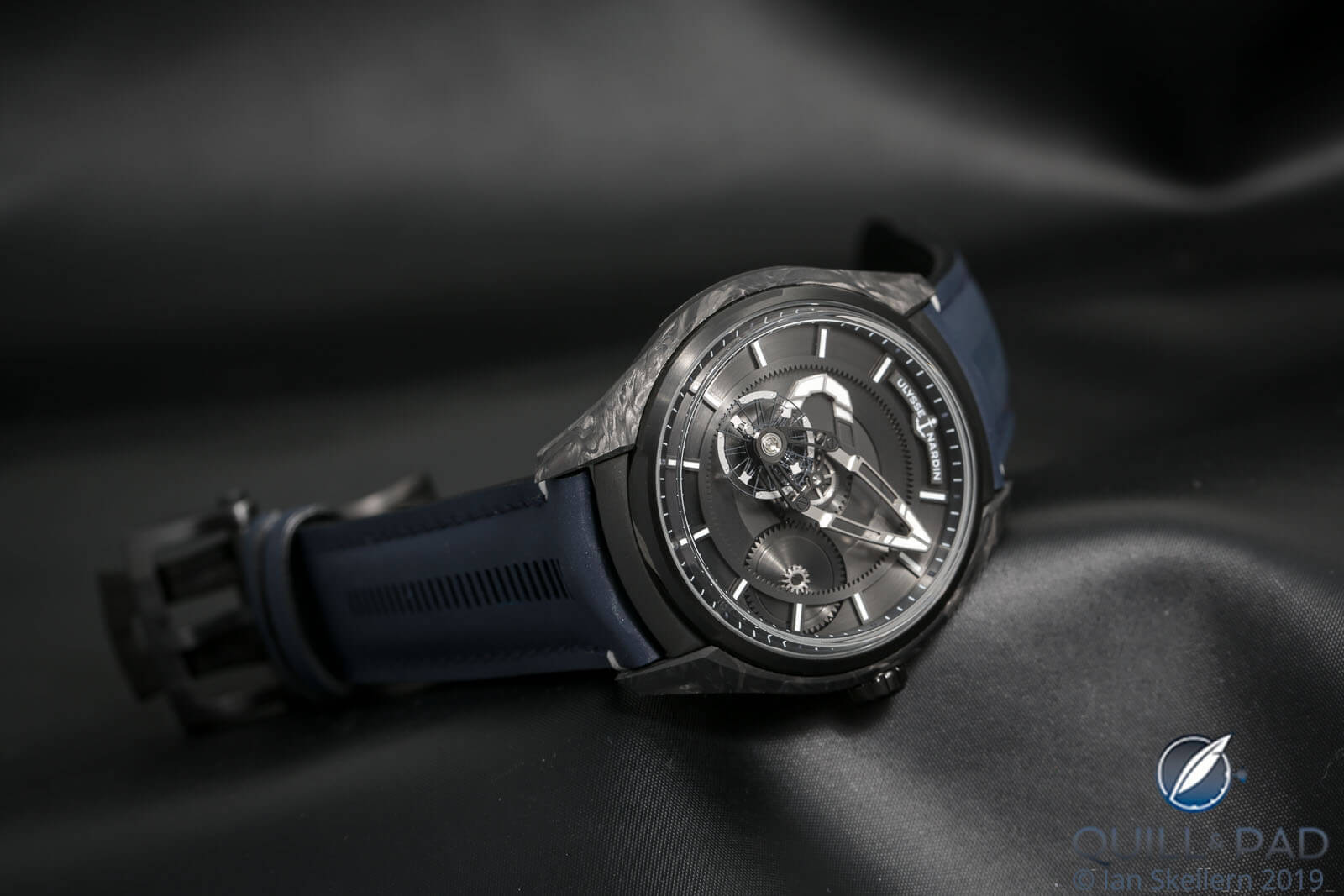
Ulysse Nardin Freak X in forged Carbonium and titanium
The Freak X is kind of like a “Thank you, here’s a little treat” for the collector community. It is a reward for all the passion and love that people have given the Freak over the years, and now the brand is doing its part to return some of the love.
When I held the Freak X in my hands I could feel that love, and I bet others could too. To Ulysse Nardin I want to say: I hear you, loud and clear, and I love you too!
Ahem . . . cough, beer . . . cough, explosions, um, wild animals.
Sorry about that, got a little carried away. How about that breakdown!
- Wowza Factor * 9.35 The wow factor comes not just from the watch itself, but from the price!
- Late Night Lust Appeal * 101.1» 991.452m/s2 This watch at this price has more than enough lust appeal to keep you up for weeks!
- M.G.R. * 64 When you have done the development to be able to make this watch at that price, the movement really is the star of the show!
- Added-Functionitis * N/A Like nearly every watch I cover (it seems) the Freak X is time only, so no need for the Gotta-HAVE-That cream, but we all know you gotta have it anyway!
- Ouch Outline * 11.2 Sunburn you didn’t notice until it was too late! Always wear sunscreen, kids. Seriously! One day I might learn, but until then I would happily take another scorcher if it meant I was able to get the Freak X on my wrist!
- Mermaid Moment * Wait, how much!? You had me at “entry level!” Even the priest did a double take!
- Awesome Total * 849.2 Take the diameter of the case in millimeters (43) and multiply with the hours of power reserve (72), then divide by the result by the water resistance in atmospheres (5), and finally, add the caliber number (230) for a stunningly awesome total!
For more information, please visit www.ulysse-nardin.com/collection/freak.
Quick Facts Ulysse Nardin Freak X
Case: 43 mm, titanium, DLC-coated titanium, 5N red gold and titanium, forged Carbonium and titanium
Movement: automatic Caliber UN-230, silicon balance wheel with nickel flyweights, flying carrousel movement, 3 Hz/21,600 vph frequency
Functions: hours, minutes
Limitation: 18 pieces each titanium and black DLC-coated titanium with silicon “marquetry” dial; other variations unlimited
Price: $21,000 in titanium and DLC-coated titanium; $24,000 in Carbonium; $29,500 for both limited editions; $30,000 in red gold
Remark: 5-year warranty
You may also enjoy:
Ulysse Nardin Freak Vision: Promises Realized
Living In Freaky Times: Ulysse Nardin FreakLab
Ulysse Nardin’s Freak Blue Cruiser
5 Of The Most Innovative Wristwatches Ever Made
Looking Back On 10 Years Of Ulysse Nardin’s Pioneering InnoVision Technology
Leave a Reply
Want to join the discussion?Feel free to contribute!



The trouble, of course, is that the Freak X is a sheep in wolf’s clothing – i.e. a Fake X, with very little in common with real Freaks.
Thanks for that. Nice article. I remember the excitement of the launch of the original. Under the influence of Oeschelin UN was always genuinely innovative. It’s good this spirit persists now the marque is part of a conglomerate. Was Ludwig involved in Freak X?
Thanks for your comment, Tim! It’s my information that Ludwig Oechslin was not involved in the Freak X.
Very cool and informative review, thanks!
Something I am unable to find is the material the minute and hours indicators are made of. Neither the height of the case. Do you know it?
I’ve learned in a video review the height of the case is 13 mm. Haven’t been able to figure out the material of the indices and minutes/hours indicators yet.
It is curious that Ulysse Nardin watch description is not very detailed.